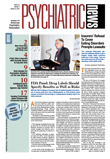At the end of a sometimes contentious nine-and-a-half-hour public advisory meeting last month, the U.S. Food and Drug Administration's (FDA) Psychopharmacologic Drugs Advisory Committee (PDAC) issued recommendations to the agency that if accepted would be precedent setting.
The PDAC recommended that the FDA add the following three items to the labels of all antidepressant medications marketed in the United States:
•
New language expanding the age range (to about age 25) covered by the existing black-box warning on increased risk of suicidal thoughts and behaviors associated with the medications in clinical-trials data.
•
New language addressing an apparent “protective effect” of the medications for older patients, detailing a significant reduction in suicidal thoughts and behaviors associated with the use of the medications in patients over age 65.
•
New precedent-setting language on the dangers of untreated mental illness.
At the center of the discussion was a 140-page report detailing the FDA's metaanalysis of suicidality in clinical trials that studied use of antidepressant medications in adults. The analysis (see
page 10) sought to determine whether there existed, for adults taking the medications in clinical trials, an increased risk of experiencing an adverse event representative of suicidal thoughts and/or behaviors, compared with patients taking placebo.
FDA staff experts in drug safety and medical statistics who conducted the metaanalysis reported an age-related risk of suicidal thoughts and behaviors associated with antidepressant therapy in which risk was higher in younger patients and lower in older ones. Those over age 65 appeared to benefit significantly from a protective effect associated with the medications.
The meta-analysis was completed using methods similar to those used in the FDA's analysis of antidepressant use and suicidality in children and adolescents, released in 2004, which resulted in the agency's imposition of black-box warnings on all antidepressant labels (Psychiatric News, October 15, 2004; November 5, 2004).
When the meeting had finally drawn to a close, the committee's stated desire to balance label warning language—directly within the black box at the beginning of the labels with language emphasizing the newly confirmed benefits of the medications for elderly patients and the dangers of leaving depression untreated—were seen by APA as somewhat of a victory.
“We welcome [the panel's] consensus findings,” said APA President-elect Carolyn Robinowitz, M.D., in a prepared statement released December 14, 2006, the day after the hearing.
“The [PDAC] reported t wo very important findings,” Robinowitz said. “First, untreated depression puts people at risk for suicide, and the label must reflect that fact; and second, antidepressant treatments show a protective effect for suicidality.”
Robinowitz also noted that the panel acknowledged preliminary data appearing to document “serious downsides to a previous label change—the black-box label on pediatric antidepressant use—adopted in 2004.” Data from the Centers for Disease Control and Prevention (CDC) suggest that since the imposition of that warning, there has been an increase in the number of deaths by suicide in adolescents—a reversal of a decade-long decline in suicides among youth.
“This new CDC information and the advisory committee's own findings on the efficacy of antidepressants in adults send a clear message,” Robinowitz said, “that antidepressant medications save lives.
She added, “While we remain concerned about the impact of any addition to the black-box [warnings], we applaud the advisory committee's suggestion that, for the first time, the FDA place statements about both risks and benefits within the current black-box label. This will help physicians and patients make appropriate, informed decisions about any proposed course of treatment.”
At times the panel's deliberations seemed to mirror the complexity of the meta-analysis it had been asked to consider. By mid-day, PDAC members had not only absorbed a large amount of data and two separate and seemingly equal analyses with largely parallel conclusions, but also the words of the numerous mental health clinicians, researchers, patient and professional advocates, and patients and family members themselves who testified before the panel.
Unlike the September 2004 meeting of the PDAC, at which the child and adolescent analysis was reviewed and where public comment was overwhelmingly in favor of restricting access to the medications, at last month's meeting 29 of 67 speakers spoke in favor of protecting access to antidepressant medications without increased warning language or restrictions on prescribing.
During t he public-comment section of the PDAC meeting, Robinowitz, along with about 20 other speakers who had joined with APA and Mental Health America in a coalition of patient and professional advocacy organizations, urged the FDA to weigh carefully the potential negative impact of expanding the warning language and the potential barrier to care increased warnings could create (see
page 10).
Darrel Regier, M.D., M.P.H., director of the APA Division of Research and the American Psychiatric Institute for Research and Education, warned the committee that basing new FDA policy regarding warning language on the latest metaanalysis would be less than prudent.
“Relying on spontaneously reported adverse-event data from clinical trials without systematic suicide-risk assessment poses many problems,” Regier said. “In fact, the current policy based on these data has led to black-box advisories, plummeting treatment rates, and undocumented `advice' on how to monitor any patient placed on antidepressant medications.”
Regier invoked the panel's own history to illustrate the profound importance of the panel's recommendations and the FDA's subsequent actions.
“If the FDA proves to have overreacted to the first round of pediatric data in 2004,” he said, “the substantial reduction in prescription[s] of [antidepressant] medications for this at-risk population [that followed the imposition of the black box] may be seen as precipitating the recent CDC-documented increase in completed suicides in the adolescent population.”
Committee Seeks Balance
After the public-comment period, PDAC panel members had several hours of discussion and debate, only to get bogged down in a 45-minute discussion of whether they should in fact take a vote on their recommendations.
In the end, all panel members agreed that the existing labels must be changed and that existing label language was far too negative, possibly resulting in access-to-care barriers.
The panel recorded two official votes, the first unanimously endorsing the idea that the current label must be changed in light of the findings of the adult meta-analysis. However, when it came down to voting on the question of whether to recommend to the FDA that the changes be made within the black box, the panel voted 5-2 in favor of altering the existing black box.
The import of the panel's final recommendations seemed lost on few, if any, in attendance.
“I cannot think of another example of a drug, or drug class, where we have ever approved language added to a label discussing the eventual outcomes of failing to treat a disease,” Robert Temple, M.D., director of the FDA Office of Medical Policy, told panel members late in the day.
The FDA is not bound to accept the recommendations of its advisory panels; however, the agency nearly always does.
At a press briefing after the meeting, Thomas Laughren, M.D., director of the FDA's Division of Psychiatry Products noted, “I think we have a very good idea of what this advisory committee thinks. Its recommendations are clear, and I would say, it is likely the agency will follow them.”▪

